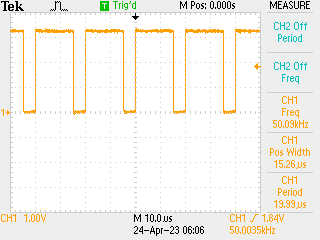Graeme Winter
Measuring µPython IRQ Time (SAMD51 edition)
Looking at being able to splice in low level IRQ handling, as a µPython module, but first of course it is interesting to (re-)measure how long the Python-implemented IRQ handlers take. Cue: usual jamboree of hooking one GPIO to another, set up a clock, and have clock, IRQ handler both toggle a GPIO:
# Blink the LED with DMA and IRQ (on, off)
#
# i.e. write the correct bit to the TGL register a few million times
# N.B. will involve DMA chaining and DMA enable / disable.
from uctypes import addressof
from machine import mem32, mem8
import time
# base addresses
MCLK_BASE = 0x40000800
GCLK_BASE = 0x40001C00
PORT_BASE = 0x41008000
DMAC_BASE = 0x4100A000
TCC1_BASE = 0x41018000
# for Grand Central: PORT_BASE |= 0x80 and LED_BIT = 0x1 << 1 for PB01
LED_BIT = 0x1 << 22
# set up LED - D13 => PA22 - already configured above
mem32[PORT_BASE | 0x8] = LED_BIT
mem32[PORT_BASE | 0x1C] = LED_BIT
# hook up 48 MHz clock
mem32[GCLK_BASE | 0x80 | 100] = (0x1 << 6) | 0x4
mem32[GCLK_BASE | 0x20 | 16] = (0x1 << 16) | (0x1 << 8) | 0x6
# configure TCC1 - we don't much care about the CC value, only the overflow
# (though we could trigger off CC and use this to measure?)
# 50 kHz / 20µs
mem32[MCLK_BASE | 0x18] |= 0x1 << 12
mem32[TCC1_BASE | 0x3C] = 2
mem32[TCC1_BASE | 0x40] = 959
mem32[TCC1_BASE | 0x4C] = 480
# configure data buffer and DMA
buffer = bytearray(4)
address = addressof(buffer)
mem32[address] = LED_BIT
# IRQ handler on D12 - toggle D13
def off(pin):
mem32[0x4100801C] = 1 << 22
from machine import Pin
led = Pin("D12", Pin.IN)
led.irq(off, Pin.IRQ_RISING, hard=True)
# get the DMA configured - depends on timer counter and global clock
# allocate part of the SRAM for DMAC working memory - each DMAC needs
# 4 words, and in the examples I looked at they needed to be 16-byte
# aligned but I have no idea if this is important - it turns out it
# probably is, so allocate extra space
dma_bfr = bytearray(2 * 16)
DESC_BASE = addressof(dma_bfr)
DWRB_BASE = addressof(dma_bfr) + 16
mem32[DMAC_BASE | 0x34] = DESC_BASE
mem32[DMAC_BASE | 0x38] = DWRB_BASE
# start actual DMA configuration - enable 0x2 and all priority?
mem32[DMAC_BASE | 0x0] = (0xF << 8) | 0x2
# select channel 0 - configure as burst with size = 1 triggered
# TCC1 OVF - chain will ensure that this keeps rolling
mem32[DMAC_BASE | 0x40] = (0x2 << 20) | (0x1D << 8)
# channel zero configuration NN in top half, do increment the source pointer
# or destination pointer and move 4 bytes, chain to #0
mem32[DESC_BASE] = (1000 << 16) | (0x2 << 8) | 0x1
mem32[DESC_BASE | 0x4] = address
mem32[DESC_BASE | 0x8] = PORT_BASE | 0x1C
mem32[DESC_BASE | 0xC] = DESC_BASE
# enable
mem32[DMAC_BASE | 0x40] |= 0x2
# trigger by enabling TCC1
mem32[TCC1_BASE] = 0x2
# should run for a while
time.sleep(60)
# disable
mem32[TCC1_BASE] = 0x0
mem32[DMAC_BASE | 0x40] &= 0xFFFFFFFC
mem32[DMAC_BASE | 0x0] = 0x0
mem32[PORT_BASE | 0x14] = LED_BIT
Result: it takes about 15.3µs to handle:
